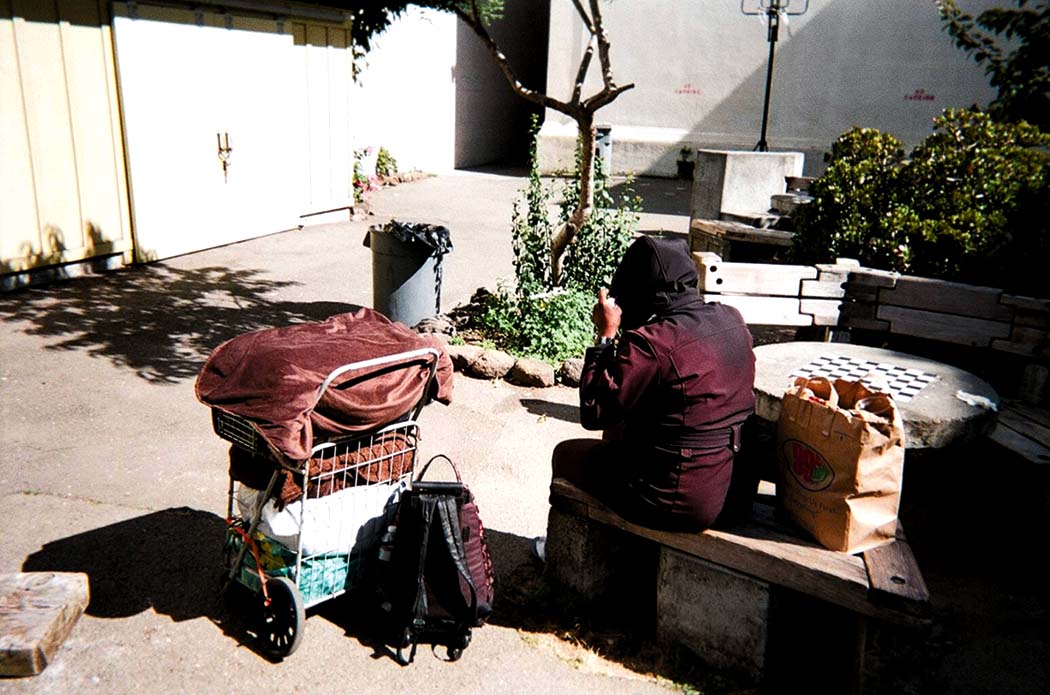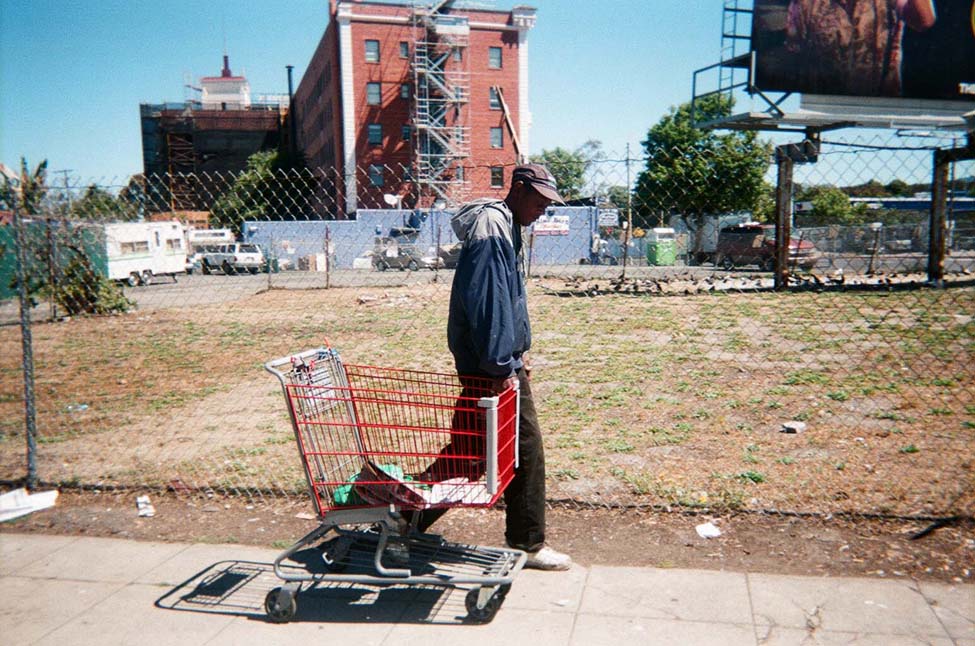by Lydia Gans
[dropcap]A[/dropcap]mong the many galleries and outdoor shows, food vendors, performers and general fun activities on Oakland’s First Friday in May was an exhibit at Uptown Body and Fender called “On Our Way Home.” It is a moving and inspiring series of photographs and statements by and about the lives of eight formerly homeless men in Oakland.
In contrast to most displays in galleries and museums, the photographers in this case were not professionals living in comfort and security while standing back and documenting the lives of “others.” They were homeless or recently homeless senior men who had lived on the streets and personally suffered the inhumane conditions they were documenting.
Each photographer had experienced the trauma of not having a place to rest and sleep, a place where they were safe from inclement weather and hostile attacks, a secure place to keep their possessions. They had experienced the deprivation of poverty as they wandered from place to place with their shopping carts, trying to obtain food and get their most basic needs met.
They were caught in a web of hopelessness and loneliness, all too often despising their own lives.
Their lives changed when they enrolled in the winter shelter program at St. Mary’s Senior Center in Oakland. St. Mary’s Center serves as a temporary home and provides meals, health care, help in finding permanent housing, and various programs and services. It also provides a community where the seniors acquire the skills and develop confidence in their own ability to redirect their lives.
Artist and photographer Taryn Evans developed the concept for the photography project. She found that Oakland has the highest percentage of homeless seniors in the country.
“It was just astounding,” she recalled. She became determined to make people aware of the extent of poverty on the streets of Oakland. “I want to bring the everyday lives of homeless seniors living in Oakland, California, to the public.”
Evans secured a grant to provide a number of homeless seniors with disposable cameras and pay them a stipend to go out and take photographs. The aim was to prepare an exhibit that would tell the public, in words and pictures, about the plight, as well as the humanity, of people who are poor and homeless in our community.
Evans connected with St. Mary’s Center. For Susan Werner, art facilitator and social worker at the Center, it was an ideal opportunity. Eight men who had gone through St. Mary’s program participated in the project. They went out in the neighborhoods to take pictures.
For six weeks, they met weekly after lunch with Susan Werner and Taryn Evans to share their experiences and select their most compelling photographs to be prepared for the exhibit. Then Evans had their images enlarged and Werner had them framed and prepared for the show.
The show is one way to bring awareness of the situation of poor and homeless seniors to the public. But just as important, if not more so, is the huge positive effect that creating this exhibit has had on the men who participated. It was this experience that made it possible for them to look back and talk about what their lives had been like on the streets.
Werner explained, “I think that when we go through traumatic experiences, it’s hard to take a look at oneself when you’re still in it. So here they had had an experience and moved through it, so their reflecting was based on the security and the accomplishment and the safety of their own home. That makes such a difference for someone to be able to talk about such a difficult experience.”
The photographers write and talk of how their lives have changed, what they have learned and can give back to the community. The title of the show, “On Our Way Home,” Werner recalls, seemed to come out spontaneously from their planning discussions. “This is what it’s like on the way home. It was apparent to us all of a sudden. It is home not only in the physical sense, but in the sense of belonging in this world as somebody.”
At the exhibit, photographer Keith Arivnwine pointed to one of his pictures titled, “It becomes acceptable,” which shows a pile of detritus on a city street. “It becomes acceptable,” he said. “You no longer notice the mess in the streets around you. You see it every day. I now have a different life and it’s not acceptable. There’s something wrong with this picture.”
After the classes and training at St. Mary’s, he wrote, “I feel good about myself and fit into the lifestyle of being housed and mentally stable.” And now he can give hope and encouragement to other people who are homeless.
Perkins Edwards likes to quote his grandfather who was a pastor. “My granddaddy used to tell us, ‘Change the way you look at things and the things you look at change.’”
Photos of free meals provided by churches and community organizations appeared in several of the displays, but one carried a special message. Vernon Andrews titled his picture, “Restoring self-esteem.” This particular meal was a lunch celebrating Father’s Day.
“It was a really touching thing,” Andrews said. Acknowledging that even a poor man can be a father “made people feel a little better about themselves. It made people inspired about restoring their self-esteem and restoring themselves to being fathers.”
Pedro Del Norte said, “I never felt homeless, I never looked homeless.” But he talked about couch surfing. “I stayed at my sister’s, and at the Richmond Mission for a night. It’s like urban camping but it’s not by choice.”
Describing his experience in St. Mary’s Center, Del Norte said, “I am in the process of creating a fulfilling life and I like to contribute to the common good. I hope that we can all come together to make the world a healthier place.”
The idea of “giving back” by reaching out to help others, and by becoming an advocate for the poor and homeless, was echoed by the man who goes by the name “Guitar” Whitfield. (Yes, he is an accomplished jazz musician and guitarist.)
Guitar “had been living a fast life,” he admits, when he suddenly became homeless. “It brought me down to earth,” he said. When he was admitted into St. Mary’s Winter Shelter, he had the opportunity to get his life in order.
Along with the basics, such as food and shelter, he was offered counseling, social skills and career development. And they found him permanent, affordable housing. Since his own experience at St. Mary’s had been so helpful, he said, “I felt like everyone should have an opportunity like I had at St. Mary’s. So they suggested I go out and tell people my story.”
Now, Guitar tells his story to people on the street and to people in power in Oakland and Sacramento. And he plays his guitar at community events that support the cause. He is a Hope and Justice Senior Advocate at St. Mary’s, traveling with his fellow seniors to public hearings and community events, and speaking out on the social issues that affect the lives of homeless people in Alameda County.
As this project developed, it became an important way for homeless men to make their voices heard, and they learned to use images to open the eyes of the public to the terrible increase in poverty and homelessness among seniors in Oakland. The physical hardships and dangers of life on the streets are shortening the life spans of seniors in tragic ways.




The photographs taken by the senior men are also meant to reflect the hope and commitment of homeless people who are trying to improve their lives. Yet, the overwhelming message of this exhibit is that far more help is needed than political officials are willing to provide. It is shocking to realize how many lives are ruined and destroyed by poverty in the affluent Bay Area in the 21st century.
Reading the men’s statements and listening to their stories, it is truly impressive to see how they have succeeded in turning their lives around. Men who were wasting their lives, and were rejected by society, not only improved their own lives, but began to reach out and help others.
With community and government support, more programs like St. Mary’s could have a big social impact. But housing is the essential element and that seems only to become increasingly inaccessible and unaffordable.
According to Werner, all but two of the seniors participating in the project have been housed, but this is highly unusual. “It often takes years to get into affordable, desirable housing,” she said.
We must make it possible for all people to find their way home.
